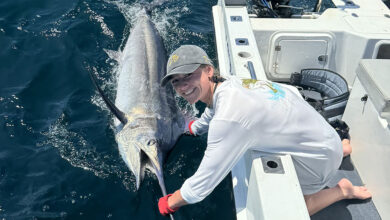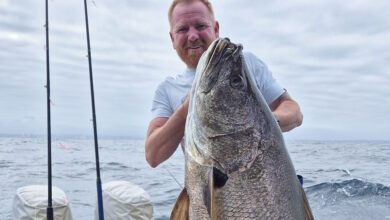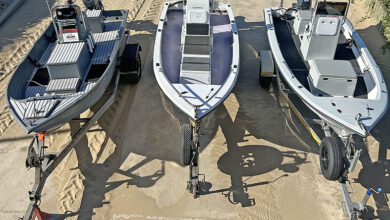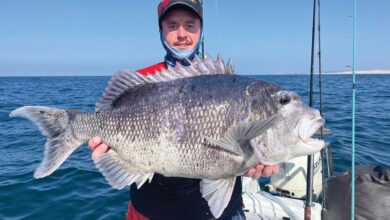THERE’S STILL LIFE IN HER
British Seagull outboards keep going decades after the factory closes
By Erwin Bursik
(Originally published in the January 2025 issue of SKI-BOAT magazine)
OUR recent “Snapshot of History” articles have produced much positive feedback from readers. Two of those responses provided us with some information on one of the front-runners that replaced the sail and/or oars as a means of propulsion for small craft.
Both Karl Hermann from Kloof in KwaZulu-Natal and Carl Krause from Benoni, Gauteng, approached us with insight into the British Seagull outboard motors that first saw “service” during the run up to World War II.
These were rugged two-stroke marine outboard motors with a relatively slow turning propeller that proved very popular for use on dinghies, tenders and small yachts.
This simple single-cylinder, water-cooled two-stroke engine was basic, with an unprotected Magneto atop, a simple carburetor, pull-cord starter, and small fuel tanks bolted on top. It was powered via a drive shaft to the gearbox and a substantial propeller that provided staunch, slow speed thrust.
They were originally manufactured in Wolverhampton in the UK around 1935, but the factory later moved to Poole and remained there until it stopped producing motors in 1996.
During WWII the Royal Engineers and Royal Navy used these motors extensively to propel folding boats and inflatables, and they gained a reputation of being virtually indestructible.
Some subsequent modifications to the original resulted in the Silver Century Plus model that manufacturers bragged could propel a displacement hull up to 26ft in length.

Karl Hermann owns a ± 50-year-old British Silver Seagull that he acquired in 2010, and which he still uses frequently on his bass boat on Inanda Dam. The dam is close to his home and allows him to access some easy fishing, but he also has a ski-boat based at Fairlands Angling Club for bay and offshore angling.
When Karl invited me to visit him and see the Seagull motor, it immediately brought back memories of when I used a Seagull as a standby motor on my original ski-boat way back in the early 1960s.
It was wrapped in plastic and kept in the centre hatch just in case the two old Johnson motors I had gave up the ghost. I pulled out the Seagull twice, if my memory serves me correctly, and then I thumb-screwed it to the transom, started it and used it to set a course back to DSBC while I tinkered with the obstinate Johnsons until I got them up and running.
I never had to rely on the Seagull to power me all the way home, but I am sure the slow and steady pace we achieved with a single Seagull only, would have got me back to Vetch’s.
When the Durban Ski-Boat Club first started, the British Seagull was very popular, usually as a second motor but there were a number of boats that used two Seagulls as their power source.
In those early days, the saying was that Seagulls were so easy to work on, that if one broke down at sea, the skipper just had to take the motor off the transom and, with minimal tools, perform a full overhaul on the deck, and it would soon be up and running again.
Physically seeing a Seagull again at Karl’s house and watching him put the pull rip cord around the flywheel was really exciting. A half-hearted pull was all it took to get the motor running beautifully with its lower unit immersed in a bucket of water. That sound alone made my day, and brought back even more memories of using a British Seagull.
I spent a good while admiring the Seagull, checking that my memories aligned with the reality of the motor. I also poked and played with it both when it was running in the tank and also thereafter when I could get up close and personal with the motor.

Here’s a summary of some of the notable points when using one of these motors:
• The starter rope slotted in the notch around the “flywheel” and the pull – haven’t done that in 40-plus years.
• The throttle lever on the tiller bar.
• The fuel tank on top of the motor that we had to shield while refueling at sea – 25:1 premix.
• The transom clamp and turn buckle to tighten it on – and the safety chain (things we don’t have to worry about these days).
• The special spring and shear pin holding the prop in place that could be changed at sea with spares held in one’s tackle box – along with some sparkplugs.
• The aft seat in the boat needed while skippering the craft using the steering arm and throttle lever.
• Finally, the sound of the un-muffled motor with the exhaust underwater.
It all brought back a lot of wonderful memories of a very different era!
Surprisingly, Karl isn’t the only one still using an old Seagull outboard. Every year on 30 December a large number of Seagull outboard owners hold a regatta on the Kariega River at Kenton on Sea especially for craft powered by British Seagulls. A massive 207 boats took part in the event at the end of 2023!

The Seagulls aren’t the only old outboard motors that have stood the test of time. Carl Krause of Camping and Boating Centre in Benoni has a hobby restoring vintage outboard motors, and he sent me this photo of a few meticulously restored outboards. He assures me that they all run sweetly when he has finished restoring them.
There’s clearly still plenty of life in these motors after the warranties run out – if they’re properly maintained.
If readers have photos of old tackle, boats or motors, or have a story to tell about the way they fished “in the old days”, they’re welcome to email them through to <sheena@mags.co.za>.






